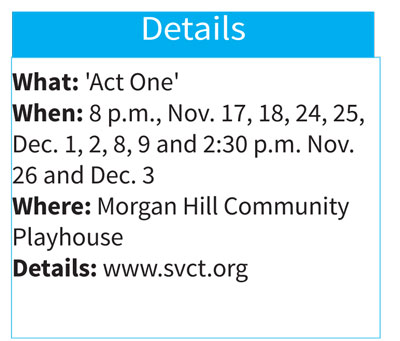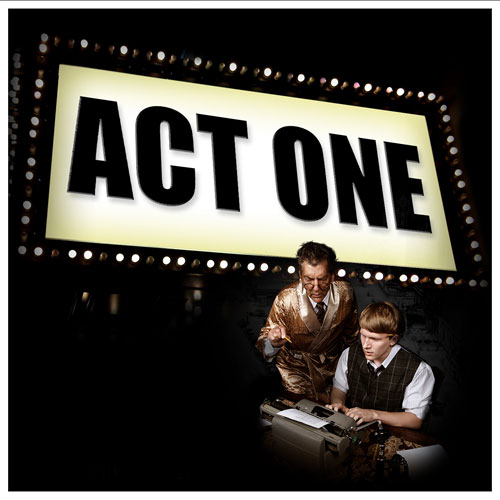SVCT’s ‘Act One’ brings to stage the story of Hart-Kaufman collaboration
Eighteen actors play 55 characters in tribute to theater creative process
Published in November 15 – 28, 2017 issue of Gilroy Life

Zack Goller, right, playing the young Moss Hart, gets playwriting advice from Rob Christopher who plays George Kaufman during a Nov. 2 rehearsal. The show dates for “Act One” are 8 p.m. Nov. 17, 18, 24, 25, Dec. 1, 2, 8, 9, and 2:30 p.m. Nov. 26 and Dec. 3. For more information, visit www.svct.org.
Photo by Marty Cheek
The creative bromance between acclaimed playwright Moss Hart and his mentor George Kaufman turns into a story of tears and cheers in “Act One,” a South Valley Civic Theatre drama opening at the Morgan Hill Playhouse Nov. 17.
Based on Hart’s best-selling autobiography “Act One,” the play is a backstage tour of the creative process, focusing on the humorous and stressful relationship of the two writers working on the comedy play “Once in a Lifetime,” their first of eight collaborations. James Lapine transformed Hart’s memoir into a play which premiered on Broadway in 2014. San Jose State University theater professor Buddy Butler directed the SVCT version.
Hart is played by three actors during various stages of his career. Sobrato High School graduate Zack Goller plays the young version. An overwhelming need to succeed in the theater world is the key to playing the role, he said.
“My character is really ambitious and driven in this show,” he said. “(Hart) comes from a poor upbringing and he has his aspirations and he knows where he wants to be in life and he doesn’t want to have his background hold him back.”
 Goller got his start on the stage in 2010 in the SVCT children’s show “Robin Hood & Friends,” playing the hero from Sherwood Forest. The experience was so fun that he continued performing in SVCT shows, including the musical “Next to Normal.” He is now studies theater at SJSU.
Goller got his start on the stage in 2010 in the SVCT children’s show “Robin Hood & Friends,” playing the hero from Sherwood Forest. The experience was so fun that he continued performing in SVCT shows, including the musical “Next to Normal.” He is now studies theater at SJSU.
Playing Hart proved to be a challenge in that Goller wanted to present him authentically.
“I’ve never done a show before that is based on real people and real events,” he said. “This is something I’ve needed to research and see who Moss Hart was as opposed to someone fictional … I would encourage audiences to come and learn about Hart’s life and see that anything is possible really and, if you put your mind to it, you can achieve your dreams.”
 Gilroy resident Rob Christopher plays dual roles as Kaufman and also Hart’s father, Barnett, a cigar-maker from London who hits hard times as an immigrant in the Bronx. Kaufman was an eccentric, which makes him a fun character for Christopher to develop some strange mannerisms to accent the writer’s odd behavior.
Gilroy resident Rob Christopher plays dual roles as Kaufman and also Hart’s father, Barnett, a cigar-maker from London who hits hard times as an immigrant in the Bronx. Kaufman was an eccentric, which makes him a fun character for Christopher to develop some strange mannerisms to accent the writer’s odd behavior.
“I think George Kaufman is a fascinating person to play because he’s very quirky and he’s a germaphobe,” Christopher said. “He wanders around doing weird things.”
As a writing mentor, Kaufman serves as a father figure for the young version of Hart, he said.
“The play is really about how they came together, how Moss Hart came from across the tracks to Manhattan and met Kaufman. They were a very odd couple who turned out to be great collaborators…. This play is for an audience who likes a good story based on true events where the humor comes sort of naturally as part of the comedy of life.”
Eighteen actors play 55 characters in “Act One” to reveal the process of crafting a story for the stage, producer Rebecca Garcia said. The two-story set is on a motorized turntable that allows the show to flow without extensive scene changes. Garcia contacted Beowulf Boritt, the set designer of the original Broadway version of the show, and asked for his advice for the SVCT version. Boritt sent her the design of his set and she and her husband, Javier Garcia, used it to build their own version depicting the various locations of New York City in the 1930s.
The production of “Act One” has been a team effort all the way around and the show stretches the theater group both technically and artistically, the producer said.
“What I like best about SVCT is that they’re not just following the norm of small theater companies,” she said. “They’re expanding and showing how diverse and amazing it is and bringing in all kinds of fresh talent.”
